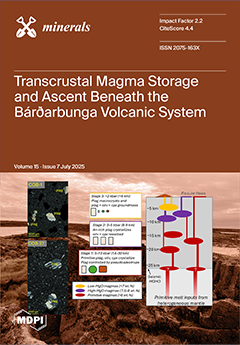The Tuztaşı low-sulfidation epithermal Au–Ag deposit (Biga Peninsula, Türkiye) records a multi-stage hydrothermal history that can be interpreted through the trace and rare-earth-element (REE) chemistry of quartz. High-precision LA-ICP-MS analyses of five representative quartz samples (23 ablation spots; 10 analytically robust) reveal two fluid stages. Early fluids were cold, dilute meteoric waters (δ
18O₍H
2O₎ ≈ −6.8 to +0.7‰), whereas later fluids circulated deeper, interacted with felsic basement rocks, and evolved in composition. Mineralized quartz displays marked enrichment in As (raw mean = 2854 ± 6821 ppm; filtered mean = 70 ± 93 ppm; one spot 16,775 ppm), K (498 ± 179 ppm), and Sb (57.8 ± 113 ppm), coupled with low Ti/Al (<0.005) and elevated Ge/Si (0.14–0.65 µmol mol
−1). Chondrite-normalized REE patterns show pronounced but variable LREE enrichment ((La/Yb)
n ≤ 45.3; ΣLREE/ΣHREE up to 10.8) and strongly positive Eu anomalies (δEu ≤ 9.3) with slightly negative Ce anomalies (δCe ≈ 0.29); negligible Ce–Eu covariance (r
2 ≈ 0.05) indicates discrete redox pulses. These signatures indicate chemically evolved, reducing fluids conducive to Au–Ag deposition. By contrast, barren quartz is characterized by lower pathfinder-element contents, less fractionated REE profiles, higher Ti/Al, and weaker Eu anomalies. A composite exploration toolkit emerges: As > 700 ppm, As/Sb > 25, Ti/Al < 0.005, Ge/Si > 0.15 µmol mol
−1, and δEu ≫ 1 reliably identify ore-bearing zones when integrated with δ
18O data and fluid-inclusion microthermometry from earlier studies on the same vein system. This study provides one of the first systematic applications of integrated trace-element and REE analysis of quartz to a Turkish low-sulfidation epithermal system, offering an applicable model for vectoring mineralization in analogous settings worldwide.
Full article





